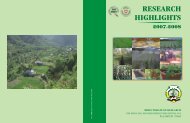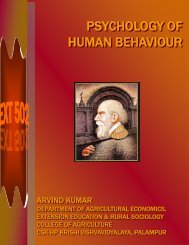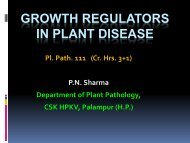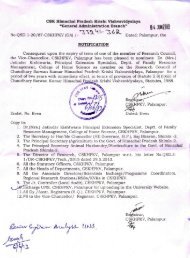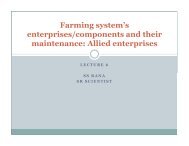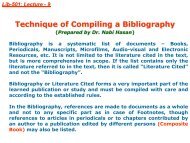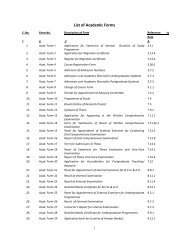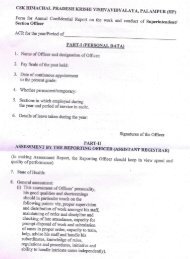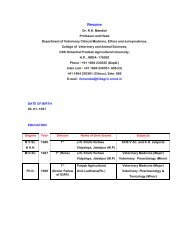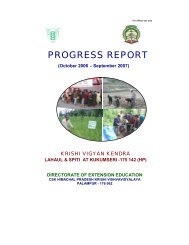animal production - CSK Himachal Pradesh Agricultural University ...
animal production - CSK Himachal Pradesh Agricultural University ...
animal production - CSK Himachal Pradesh Agricultural University ...
You also want an ePaper? Increase the reach of your titles
YUMPU automatically turns print PDFs into web optimized ePapers that Google loves.
Colostrum should be given @ 1/10th of body weight of the calf. Colostrum from the mother should be fed 2 times<br />
during winter and three times during summer, a day for the first 3-4 days. In case the mother dies immediately after birth<br />
then in place of colostrum the calf should be given 5 ml of caster oil (for one day), 5 ml of fish liver oil and one egg twice<br />
daily for the first 4 days alongwith the milk from some other cow. Within 2 hours of first suckling, calf generally passes<br />
muconium (first faeces). If this does not occur, anema with a teaspoonful of sodium bicarbonate in one litre of luke warm<br />
water may be given.<br />
Calves raised on a limited milk feed system must be encouraged to eat succulent fodder and concentrate at an<br />
early age, but at the same time do not overfeed them. From 15th day onwards, calf should be offered calf starter ration.<br />
Weaning: In calves, weaning should be adopted. Separate the calf at birth. Weaning helps in recording the actual milk<br />
yield of the <strong>animal</strong>, regulates the milk feeding according to calf-requirements, avoids injury to teats, checks the transmission<br />
of infectious diseases, and solves the problem of mother instinct in case the calf dies. To the weaned calves, feed fresh milk<br />
at body temperature(39o-40oC). Nipple feeding can also be practised.<br />
Disbudding: Disbudding of buffalo calves and cow calves should be done between 7-10 and 15-20 days after the birth<br />
respectively with a red hot dehorner. Clip the hair around the horn and apply vaseline ring. Then put the red hot iron on the<br />
bud and move it in circle. Apply antiseptic cream on the wound.<br />
Identification: Proper identification of the <strong>animal</strong>s is necessary if the number of <strong>animal</strong>s in the herd is large. In youg calves<br />
tatooing in ears or tags in chains around the neck can be used for the identification of calves. In heifers or adult cows ear<br />
tags or branding can be followed.<br />
Extra (super mammary) teats which give an ugly appearance and also interfere in milking should be removed at 1-<br />
2 months of age surgically. Clip the super mammary teats with disinfected curved scissors and apply antiseptic cream, if it<br />
is not too close to the normal teat, otherwise, take the help of veterinarian. Calves should be kept free from ectoparasites<br />
(lice, ticks) by grooming, washing, keeping them clean and by regular spraying of insecticides. Proper deworming and<br />
vaccination schedule should be followed.<br />
Care of heifer: A target of 500-700 g daily weight gain of the dairy heifers can be obtained by feeding balanced ration of<br />
concentrate and good quality green fodder. The <strong>animal</strong> should attain 200-250 kg of body weight at 15 months of age and<br />
should have 300 kg weight at 18 months. Heifer should be observed for symptoms of heat after one year of age. If herd size<br />
is large, regular bull parading with vasectomized bull should be done.<br />
Care and feeding of the milking herd: Animal should be shifted on normal concentrate mixture after 5 days of calving.<br />
Concentrate allowance should be increased gradually depending upon the increase in milk yield and the quality and quantity<br />
of green fodders available. Milking <strong>animal</strong>s particularly the high yielders loose their body weight during first three months of<br />
their lactation. Milch <strong>animal</strong>s should be fed concentrate and green fodder as given in the schedule.<br />
Composition of calf starter and replacer (parts)<br />
Sr.No. Ingredients Calf starter <strong>CSK</strong>HPKV, milk replacer<br />
I II III<br />
A. Composition<br />
1. Wheat/wheat flour 10 - 30 10<br />
2. Maize 15 42 10 -<br />
3. Wheat bran 25 20 10 -<br />
4. Groundnut cake 25 20 - 9<br />
5. Fish meal (Jawla type) 5 7 7 12<br />
6. Molasses 5 - - 10<br />
7. Soyaflakes 12 8 10 10<br />
8. Sesamum cake - - - 10<br />
9. Coconut oil - - - 7<br />
10. Linseed - - - 14<br />
11. Citric acid - - - 3<br />
17



